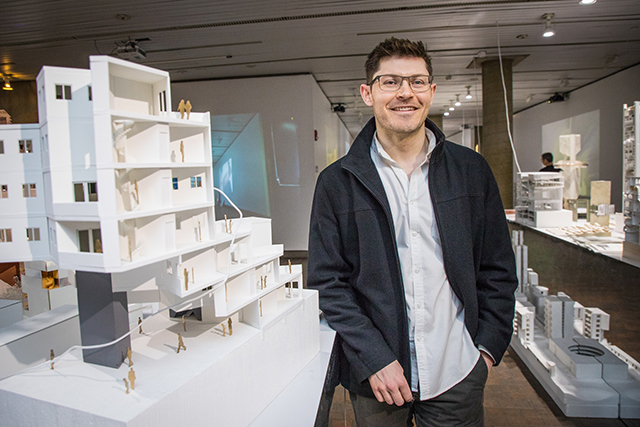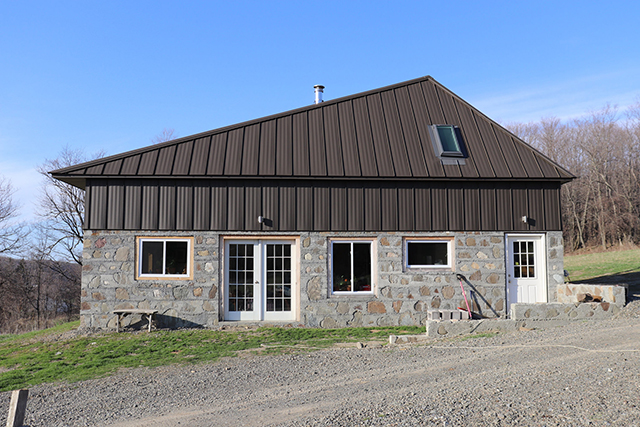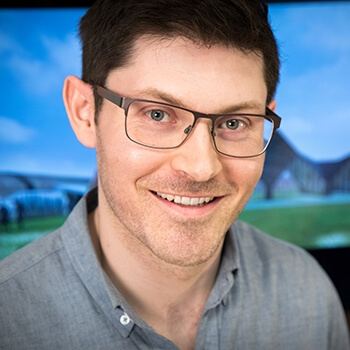Jeremy Burke, M.D.E. '18, was drawn to the field of architecture because he thought it would be a good mix of science and art. (Photo by Eliza Grinnell/SEAS Communications)
How did you become interested in architecture?
It all really started when I took a geometry honors course in high school. For one project, we used a set of building components to build a large, complex structure. I became really interested in the form and shape of the structures. When I was looking to continue my studies, I thought that architecture would be a really good mix between the sciences and the arts.
Tell us about the renewable energy project you worked on during your undergraduate studies at Cornell.
I worked in the lab of one of my professors, Dana Cupkova, on a wind turbine design project. The concept behind the project was looking at new ways to generate electricity, as well as create a shared social space that is also sheltered from the elements. We used a combination of different design tools to create small wind turbines and piezoelectric tape that would generate electricity as the wind blew past. The project was a mix of using design aesthetics along with computational tools to generate a high-performance object that could really deliver a lot of electricity, while at the same time being pleasant to be around. Through that experience, I learned how computational design tools can be deployed in architecture.
During your time at Cornell, you were involved in a project called Hither Yon. Tell us about that.
Hither Yon was basically a creative team with three of my fellow Cornell classmates. We developed a collaborative approach to making art and design. While living and working in Berlin, we used the concepts of the id, ego, and superego to collaborate on a series of related art works. For the id, each individual had a certain number of squares on a single drawing to fill in to their own liking. For the ego component, we took the drawings and worked together to develop a single drawing of our own design concept. Then for the superego component, we created a large room installation where we painted and created an environment where the drawings would exist inside a space. That project really taught me about the benefits of collaboration— by working with others, you can really create something larger than what you can do on your own. We had a really great synergy in the way we worked together, and through that, the art we were able to make was pretty profound.

Through his work in the M.D.E. program, Burke has learned that it is necessary to look at the whole system when tackling a problem. (Photo by Eliza Grinnell/SEAS Communications)
Before enrolling in the Master in Design Engineering (MDE) program, you worked for several different architectural firms. What were some of your most interesting experiences?
One really great experience I had was at an architectural firm in Boston, Kennedy Violich Architects. I was tasked with helping design one of the last components of their smart house, which was designed and built in Hamburg, Germany. For that project, we did a lot of analysis of how to best design curtains that were both aesthetically pleasing and functional—the functions they incorporated were light and acoustics, and they also served as a power source. It was great because I was able to work with a team of engineers to design the electrical system for the curtains. I was also able to travel to Hamburg and work with the construction teams on site to help install and, ultimately, realize the curtains inside the space. The lighting pattern in the curtain was connected to the wind speed outside of the building; when it was very windy, the pattern would change. It was a novel connection between interior and exterior through the electrical system and the central computer of the house.
Tell us about your collaborative project in the first-year of the MDE program.
For our collaborative projects, we were given the topic of the food system. Our team decided to look into problems surrounding the local food system. We found that a lot of the small- and mid-scale farmers lacked the same infrastructure and support that’s been developed for large agribusiness. Through many interviews and research into the topic, we ultimately decided on the concept of an agricultural cluster, which would be a set of buildings that would be spatially located next to a group of farmers within a specific region in the Northeast. The facility would have a number of different offerings, but it would ultimately be a community center for the farmers where they could both sell their food as well as access a variety of different resources to help them in their daily activities.
What was the most important lesson you learned from that project?
The most important lesson I learned from that project was what the core of the master in design engineering is about: looking at problems systematically to understand the seemingly unrelated components that contribute to the problem. Through this, we had to understand both the problems of the farmers on one side, but then also the challenges for the consumers on the other. And it wasn’t really until we addressed and created a solution that worked for both parties that we were able to be successful.
From that project, you are looking to launch a startup?
After the first-year design studio, we continued to develop the project outside of the academic realm, and have applied to the Harvard Innovation Labs, where we are developing the project. For the startup, we would essentially begin to run a one-year test pilot to see how we can build operations in the supply chain to make this type of agricultural cluster feasible. From there, we could begin to raise capital and ultimately build a larger facility in an area like Worcester or another city in Massachusetts.

While Burke was an undergrad at Cornell University, he designed this farmhouse for his German professor. (Photo provided by Jeremy Burke)
What have you been working on for your independent project?
I’ve taken some of the spatial economics principles from our collaborative project and applied them to cities to understand how groups of individuals and businesses can come together to create innovation districts. We hope this tool can be a platform that can help city governments, developers, and architects have a true analysis of how cities function. This tool could help them make decisions about where development opportunities could happen in a city.
What’s it like to look at city planning through the lens of architecture?
From the architect’s point of view, this is really about the spaces that are available for people within the city and how those spaces are distributed around the city. I believe that there is a real connection between the essence of a place and its built form. So if we can begin to measure that and understand how these different spaces work in different cities across the United States and in Europe, we can have a better understanding of how to create the best types of spaces going forward.
Why has the MDE program been a good experience for you?
It has been a really great experience for me, since the program has focused on requiring students to show and prove that their ideas are really grounded, both from a design perspective, but also from an engineering and an analytical perspective. I’ve learned that it’s necessary to look at the whole system when tackling a problem.
Name: Jeremy Burke
Degree program: Master in Design Engineering (MDE)
Graduation year: 2018
Hometown: Santa Fe, New Mexico
Hobbies: Training for triathlons, listening to live music
Fun fact: While he was an architectural student, Burke designed a small farmhouse for his German professor at Cornell.
Jeremy Burke, M.D.E. '18
Master of Design Engineering student Jeremy Burke discusses his two years as a graduate student in Harvard's first joint program offered by the John A. Paulson School of Engineering and Applied Sciences and the Graduate School of Design.
Press Contact
Adam Zewe | 617-496-5878 | azewe@seas.harvard.edu
